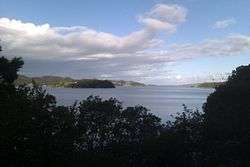Whangaruru
Whangaruru is a rural community and harbour on the east coast of Northland, New Zealand. Mokau, Helena Bay, Whakapara, Hikurangi and Whangarei are to the south and the Bay of Islands is to the northwest.[1][2]
Whangaruru | |
|---|---|
 | |
 Whangaruru | |
| Coordinates: 35°20′51″S 174°19′35″E | |
| Country | New Zealand |
| Region | Northland Region |
| District | Whangarei District |
The Whangaruru area includes the villages of Punaruku west of the harbour, Whangaruru north of the harbour, and Whangaruru North east of the harbour.
The area was reputedly named by Puhimoanariki who was sailing up the coast. After searching for a long time he found shelter from bad weather there.[3] The name "Whangaruru" is a Māori-language word meaning "sheltered harbour",[4] and is a direct linguistic cognate with "Honolulu" in the related Hawaiian language.
History and culture
The Ngātiwai hapū of Te Uri o Hikihiki are the indigenous people of Whangaruru.
The hapū has several traditional meeting grounds in the Whangaruru and Panaruku area, including the Ngātiwai Marae and Ngāti Wai Soldiers' Memorial Hall, the Ōtetao Reti Marae and Hoori Reti meeting house, and the Tuparehuia Marae.[5][6]
Demographics
| Year | Pop. | ±% p.a. |
|---|---|---|
| 2006 | 2,067 | — |
| 2013 | 2,100 | +0.23% |
| 2018 | 2,520 | +3.71% |
| Source: [7] | ||
The statistical area of Whangaruru, which at 469 square kilometres is much larger than this community, had a population of 2,520 at the 2018 New Zealand census, an increase of 420 people (20.0%) since the 2013 census, and an increase of 453 people (21.9%) since the 2006 census. There were 858 households. There were 1,323 males and 1,197 females, giving a sex ratio of 1.11 males per female. Of the total population, 525 people (20.8%) were aged up to 15 years, 396 (15.7%) were 15 to 29, 1,170 (46.4%) were 30 to 64, and 432 (17.1%) were 65 or older. Figures may not add up to the total due to rounding.
Ethnicities were 77.1% European/Pākehā, 35.7% Māori, 3.2% Pacific peoples, 1.1% Asian, and 1.5% other ethnicities. People may identify with more than one ethnicity.
The percentage of people born overseas was 10.5, compared with 27.1% nationally.
Although some people objected to giving their religion, 54.6% had no religion, 33.6% were Christian, and 3.3% had other religions.
Of those at least 15 years old, 267 (13.4%) people had a bachelor or higher degree, and 426 (21.4%) people had no formal qualifications. The median income was $24,300. The employment status of those at least 15 was that 867 (43.5%) people were employed full-time, 306 (15.3%) were part-time, and 132 (6.6%) were unemployed.[7]
Education
Whangaruru School is a coeducational full primary (years 1-8) school with a roll of 59 students as of March 2020.[8][9] The school was founded in 2005 to replace Punaruku, Ngaiotonga Valley and Helena Bay Schools. It is on the site of the old Punaruku School.[10]
Te Kura Hourua ki Whangaruru was a secondary (years 9-13) partnership school opened in 2014,[11] and closed in 2016.[12]
External links
| Wikimedia Commons has media related to Whangaruru. |
Notes
- Peter Dowling (editor) (2004). Reed New Zealand Atlas. Reed Books. pp. map 5. ISBN 0-7900-0952-8.CS1 maint: extra text: authors list (link)
- Roger Smith, GeographX (2005). The Geographic Atlas of New Zealand. Robbie Burton. pp. map 21. ISBN 1-877333-20-4.
- "History of Whangaruru". Department of Conservation.
- "Whāngārei tribes - Ancestors". Te Ara: The Encyclopedia of New Zealand.
- "Te Kāhui Māngai directory". tkm.govt.nz. Te Puni Kōkiri.
- "Māori Maps". maorimaps.com. Te Potiki National Trust.
- "Statistical area 1 dataset for 2018 Census". Statistics New Zealand. March 2020. Whangaruru (104900). 2018 Census place summary: Whangaruru
- "New Zealand Schools Directory". New Zealand Ministry of Education. Retrieved 26 April 2020.
- Education Counts: Whangaruru School
- "Mergers, Closures and New Schools, January 2005 - December 2005" (XLS). Education Counts.
- "Te Kura Hourua ki Whangaruru web site". Te Kura Hourua ki Whangaruru. Archived from the original on 5 December 2013.
- Gerritsen, John (28 January 2016). "Charter school a waste of public money - PPTA". Radio New Zealand.